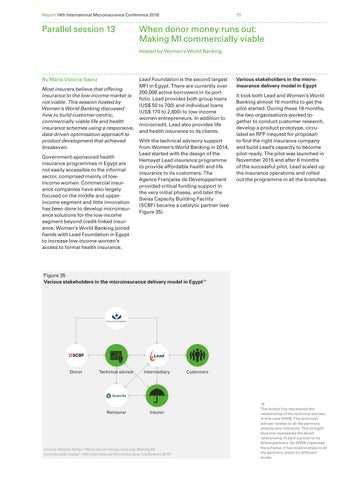Report 14th International Microinsurance Conference 2018
Parallel session 13
75
When donor money runs out: Making MI commercially viable Hosted by Women’s World Banking
By Maria Victoria Sáenz Most insurers believe that offering insurance to the low-income market is not viable. This session hosted by Women’s World Banking discussed how to build customer-centric, commercially viable life and health insurance schemes using a responsive, data-driven optimisation approach to product development that achieved breakeven. Government-sponsored health insurance programmes in Egypt are not easily accessible to the informal sector, comprised mainly of lowincome women. Commercial insurance companies have also largely focused on the middle and upperincome segment and little innovation has been done to develop microinsurance solutions for the low-income segment beyond credit-linked insurance. Women’s World Banking joined hands with Lead Foundation in Egypt to increase low-income women’s access to formal health insurance.
Lead Foundation is the second largest MFI in Egypt. There are currently over 200,000 active borrowers in its portfolio. Lead provides both group loans (US$ 50 to 700) and individual loans (US$ 170 to 2,800) to low-income women entrepreneurs. In addition to microcredit, Lead also provides life and health insurance to its clients. With the technical advisory support from Women’s World Banking in 2014, Lead started with the design of the Hemayet Lead insurance programme to provide affordable health and life insurance to its customers. The Agence Française de Développement provided critical funding support in the very initial phases, and later the Swiss Capacity Building Facility (SCBF) became a catalytic partner (see Figure 35).
Various stakeholders in the microinsurance delivery model in Egypt It took both Lead and Women’s World Banking almost 16 months to get the pilot started. During these 16 months, the two organisations worked together to conduct customer research, develop a product prototype, circulated an RFP (request for proposal) to find the right insurance company and build Lead’s capacity to become pilot-ready. The pilot was launched in November 2015 and after 6 months of the successful pilot, Lead scaled up the insurance operations and rolled out the programme in all the branches.
Figure 35 Various stakeholders in the microinsurance delivery model in Egypt15
Donor
Technical advisor
Reinsurer
Intermediary
Insurer
Source: Shastri, Shilpi “When donor money runs out: Making MI commercially viable” 14th International Microinsurance Conference 2018
Customers
15 The dotted line represents the relationship of the technical adviser, in this case WWB. The technical adviser relates to all the partners, directly and indirectly. The straight blue line represents the direct relationship of each partner to its fellow partners. As WWB organised the scheme, it has relationships to all the partners, albeit on different levels.























